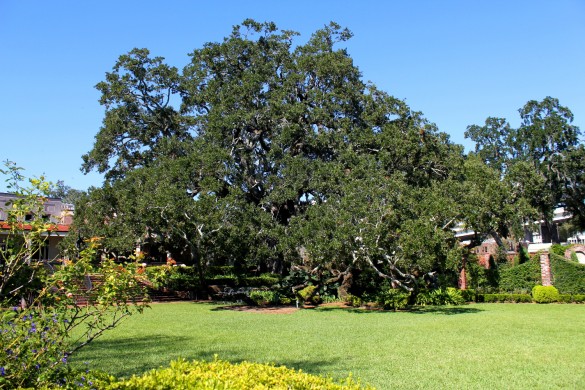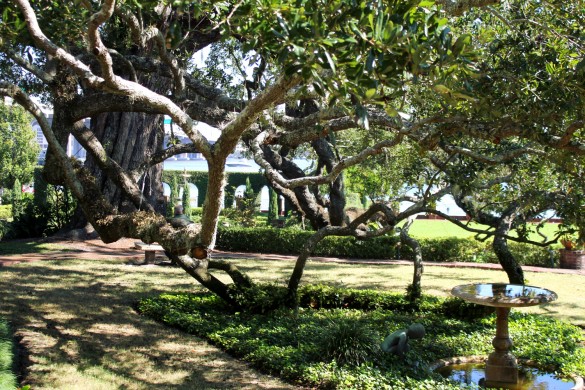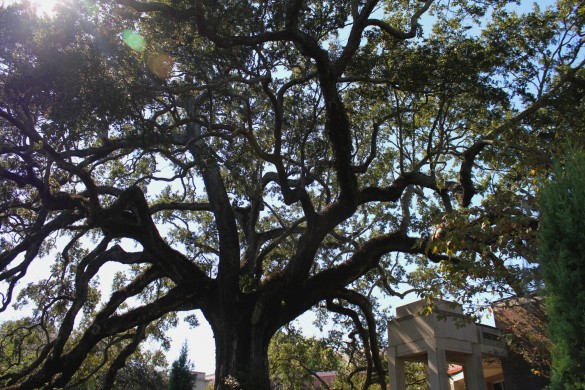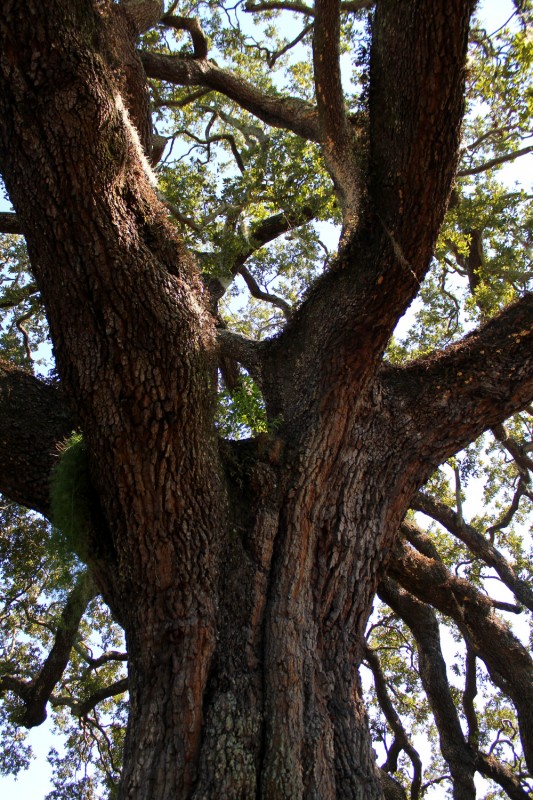 A focal point of The Cummer’s riverside Gardens is The Cummer Oak; a live oak tree (Quercus virginiana) of around 200 years. With a twenty three to twenty five foot circumference (a 7 to 8 foot diameter), a height of 70 to 80 feet, and a 150 foot spread of its branches; the Cummer Oak dominates the landscape. A “home” for some, or just a place to visit or dine; the live oak is estimated to interact in one way or the other, with 100 species of plants and animals. Amongst the species are black bear, squirrels, the threatened Florida scrub jay, frogs, lizards, Spanish moss, resurrection fern, and of course, people.
A focal point of The Cummer’s riverside Gardens is The Cummer Oak; a live oak tree (Quercus virginiana) of around 200 years. With a twenty three to twenty five foot circumference (a 7 to 8 foot diameter), a height of 70 to 80 feet, and a 150 foot spread of its branches; the Cummer Oak dominates the landscape. A “home” for some, or just a place to visit or dine; the live oak is estimated to interact in one way or the other, with 100 species of plants and animals. Amongst the species are black bear, squirrels, the threatened Florida scrub jay, frogs, lizards, Spanish moss, resurrection fern, and of course, people.
We, people, enjoy the shade and the beauty of the live oak; with its sweeping branches draped with Spanish moss, the live oak gives us a sense of place. From Virginia to Texas, live oaks have proven to be aesthetically valuable, in natural and, private and public landscape designs. Walt Whitman wrote a poem about the live oak, “I Saw in Louisiana a Live-Oak Growing”, and in 1934 the Live Oak Society was started whose membership, except for one human chairperson, is all live oak trees. (Starting with 43, the Society is now 7252 members strong.) The live oak holds a special place in our daily lives, memories, and history.
Though today, only available locally in certain locations, live oak is used for cabinetry, furniture, interior trim, flooring, boatbuilding, barrels, and veneer. There was a time; however, that the wood of the live oak was so valuable in shipbuilding, that overharvesting by private and governmental enterprises, including “timber pirates” decimated the old growth forests. So important was this wood that the United States purchased land near Pensacola, Florida and President John Quincy Adams started the first, and only, federal tree farm on the site. Actions like this, the decrease of readily available live oak trees, and the advent of the iron boat hull, saved the remaining forests.
Making live oak such a prize is due to many factors; it is resistant to disease and decay, it is water resistant, it lasts a long time, and is strong. The natural growth patterns and branch shapes made the perfect structural components for wooden sailing ships; supplying hull ribs, and support parts. The high density (a branch six foot in length and 10 inch diameter could weigh as much as 325 pounds) contributes to its strength and durability.

Amazingly, a cubic foot of dry live oak wood (a cube one foot high by one foot long by one foot deep) weighs about 65 pounds, heavier than an eight year old (2001 CDC Growth Charts put an average 8 year old at about 4 foot 2 inches and 57 pounds). But how does this density contribute to its strength? What is strength?
Strength can broadly be looked at as how much energy can be applied to a material before the structure of that material is affected; broken, crushed, twisted, bent, or torn. This energy is often referred to as a load applied to the material; tension, compression, torsion, bending, and shearing. Typically, with a given material type (wood, metal, ceramics, plastics), the more tightly packed the substance is that makes up the material, the more energy that can be applied before that material is affected; broken, crushed, twisted, bent, or torn.

How tightly or loosely packed a substance is, is a measure of the materials density. The tighter the substance is packed, the higher the density of the material. Density is mathematically defined as the mass per unit volume; how much stuff in a given space. The “heavier” (the one with more mass) of two pieces of wood of the same size, has the higher density of the two.
Looking at a chart that shows density vs. strength; within the material type “wood”, oak and certain pines have higher densities and are stronger than the lower density balsa wood. Let’s take this to the kitchen and bake some cakes, each requiring a cup of sugar. The recipes are the same except that cake 1 says a cup of loosely packed sugar, and cake 2 says a cup of packed sugar. Right away we know that cake 2 will be sweeter, we pressed more sugar into the cup, got rid of the air spaces and replaced it with sugar; packed sugar is denser than loose sugar, it has more stuff in a given space.

Now, before you add the sugar to the cakes, take your finger and push it into the cup of loose sugar, it doesn’t take too much effort to bury your finger to the first knuckle. Now do the same with the cup of packed sugar, it takes a little more energy to get your finger poked down to that first knuckle. That increased difficulty is a measure of the increased strength of the packed sugar over the loose sugar. Denser materials can absorb or resist more energy before they “give”.
So, next time you are admiring a live oak, whether it be in our backyard or yours, admire it for its majestic beauty and its phenomenal strength, and your experience will be twice as sweet.



